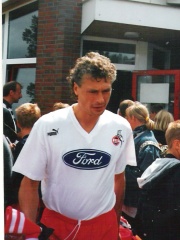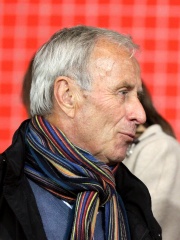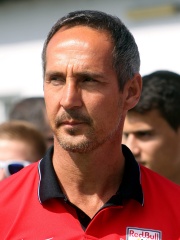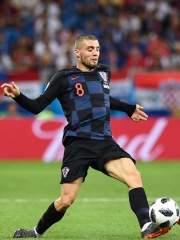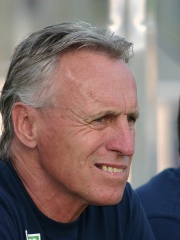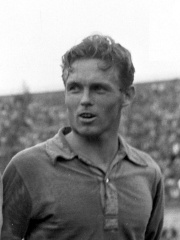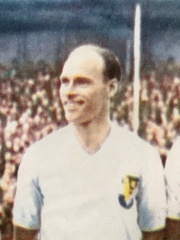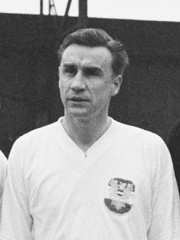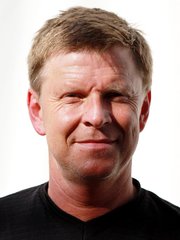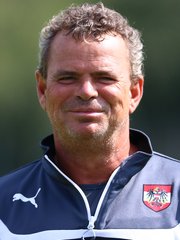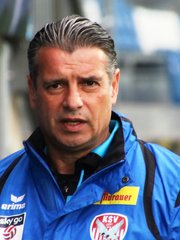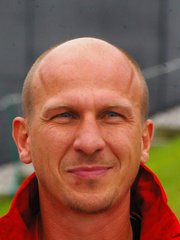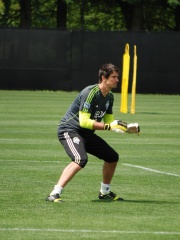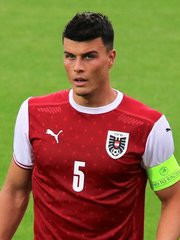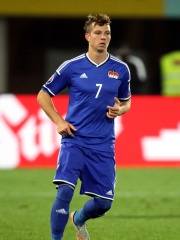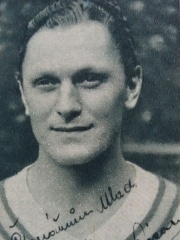
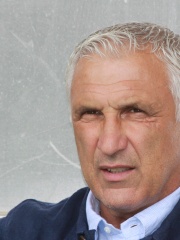



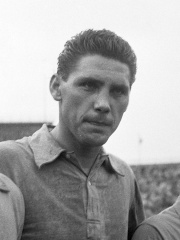


The Most Famous
SOCCER PLAYERS from Austria
This page contains a list of the greatest Austrian Soccer Players. The pantheon dataset contains 21,273 Soccer Players, 238 of which were born in Austria. This makes Austria the birth place of the 21st most number of Soccer Players behind Russia, and Mexico.
Top 10
The following people are considered by Pantheon to be the top 10 most legendary Austrian Soccer Players of all time. This list of famous Austrian Soccer Players is sorted by HPI (Historical Popularity Index), a metric that aggregates information on a biography's online popularity. Visit the rankings page to view the entire list of Austrian Soccer Players.

1. Josef Bican (1913 - 2001)
With an HPI of 75.26, Josef Bican is the most famous Austrian Soccer Player. His biography has been translated into 43 different languages on wikipedia.
Josef "Pepi" Bican (25 September 1913 – 12 December 2001) was an Austrian and Czech professional footballer who played as a striker. He is regarded by some to be the greatest goalscorer in the history of the sport. He is considered by RSSSF as the third-most prolific goalscorer in history after Erwin Helmchen and Cristiano Ronaldo, with over 950 goals scored in 624 official matches. He scored 591 goals in 301 official games for Slavia Prague across his 11-year playing career at the club. Bican began his professional career at Rapid Vienna in 1931. After four years at Rapid, he moved to local rivals Admira Vienna. Bican won four league titles during his time in Austria, moved to Slavia Prague in 1937, where he stayed until 1948, and became the club's all-time top goalscorer. He later played for FC Vítkovice, FC Hradec Králové, and Dynamo Prague, retiring in 1955 as the all-time top goalscorer in the Czechoslovak First League with 447 goals. According to UEFA, the governing body for European football, he is the leading all-time goalscorer in European top-flight leagues with 518 goals (447 in Czechoslovakia and 71 in Austria), narrowly ahead of Hungarian Ferenc Puskás. Bican was a member of the Austrian Wunderteam of the 1930s and represented the nation at the 1934 FIFA World Cup, where they reached the semi-finals. He later switched allegiance to the Czechoslovakia national football team, but a clerical error related to his transfer of national team precluded him from playing in the 1938 FIFA World Cup. Bican was a tall and powerful player, with the technical ability to play with both feet, and had considerable pace. During his athletic prime, he was reportedly capable of running 100 metres in 10.8 seconds, which was not far off the leading sprinters of his time. After his retirement from playing, Bican became a manager, and coached various teams from the 1950s until the 1970s. In 1998, Bican was given a "Medal of Honour" by the International Federation of Football History & Statistics (IFFHS) for being among the world's most successful top division goalscorers of all time. In 2000, the IFFHS awarded Bican the "Golden Ball" in recognition of his status as the greatest goalscorer of the 20th century. The award was based on how many times a player had been top scorer in his top division domestic league, a feat which Bican achieved 12 times.

2. Hans Krankl (b. 1953)
With an HPI of 66.38, Hans Krankl is the 2nd most famous Austrian Soccer Player. His biography has been translated into 45 different languages.
Johann "Hans" Krankl (German: [hans ˈkʁaŋkl̩]; born 14 February 1953) is an Austrian former professional footballer. A prolific striker, he is regarded by many as one of Austria's greatest players.

3. Franz Binder (1911 - 1989)
With an HPI of 62.95, Franz Binder is the 3rd most famous Austrian Soccer Player. His biography has been translated into 24 different languages.
Franz "Bimbo" Binder (1 December 1911 – 24 April 1989) was an Austrian football player and coach who played as a centre forward. Internationally he represented the Austria national team and, during the Anschluss, the Germany national team. He played internationally immediately following the Austrian "Wunderteam" of 1931-32. He is the all time leading scorer of Rapid Wien with 1006 goals in 757 games and regarded as one of the greatest Austrian players of all time. In his whole career he would score 1202 goals in 831 matches. With an average-score of 1.44 goals per match, he is among the most prolific scorers in football history. Binder is one of only a few players to score more than 1200 goals in his professional career alongside Lajos Tichy, Josef Bican, Gerd Müller, Ferenc Puskás, Ferenc Deák, Erwin Helmchen and Pelé.

4. Friedrich Koncilia (b. 1948)
With an HPI of 62.83, Friedrich Koncilia is the 4th most famous Austrian Soccer Player. Her biography has been translated into 41 different languages.
Friedrich Koncilia (born 25 February 1948) is an Austrian former professional football who played as a goalkeeper.
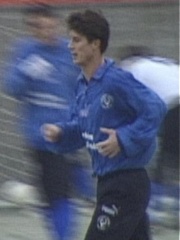
5. Brian Laudrup (b. 1969)
With an HPI of 62.57, Brian Laudrup is the 5th most famous Austrian Soccer Player. His biography has been translated into 44 different languages.
Brian Laudrup (Danish pronunciation: [ˈpʁiːæn ˈlɑwˀtʁɔp], born 22 February 1969) is a Danish former professional footballer who played as a forward, winger, or midfielder. He currently works for the various TV sports channels of Scandinavian media network Viaplay. He also manages a football academy for marginalised youth. Laudrup is the son of Danish former footballer Finn Laudrup and the younger brother of footballer Michael Laudrup. During his playing career which eventually stalled due to injury, Laudrup represented a number of European clubs. He started with Danish club Brøndby, winning two Danish championships in the late 1980s. He then played for German and Italian clubs, winning the 1993–94 Serie A as well as the 1994 UEFA Champions League title with Milan. He was a vital part of the Rangers team which dominated the Scottish Premier Division in the 1990s, winning three championships, among others. He won the 1998 UEFA Super Cup in his brief stint with English club Chelsea, followed by a short spell with Copenhagen in Denmark, before ending his career with Ajax in 2000. Laudrup also played 82 matches and scored 21 goals for the Denmark national team, and was a vital part of the Danish teams which won UEFA Euro 1992 and the 1995 Confederations Cup. Laudrup won the Danish Football Player of the Year award a then record four times. It has since been beaten by Christian Eriksen who in 2018 won the award for the fifth time. Laudrup was named by FIFA as the fifth-best player in the world in 1992 and was named by Pelé as one of the top 125 greatest living footballers at the FIFA 100 ceremony in March 2004, alongside his older brother, Michael.

6. Erich Probst (1927 - 1988)
With an HPI of 62.52, Erich Probst is the 6th most famous Austrian Soccer Player. His biography has been translated into 26 different languages.
Erich Probst (5 December 1927 – 16 March 1988) was an Austrian footballer who played as a striker.

7. Ernst Ocwirk (1926 - 1980)
With an HPI of 62.31, Ernst Ocwirk is the 7th most famous Austrian Soccer Player. His biography has been translated into 24 different languages.
Ernst Ocwirk (7 March 1926 – 23 January 1980) was an Austrian football player and coach. A former midfielder, he is regarded as one of the greatest Austrian men's footballers of all time. He spent the majority of his playing and coaching years between Austria and Italy, being both player and manager for FK Austria Vienna and Serie A club Sampdoria. He also went on to become a member of the Austria national team, which he led to a third-place finish at the 1954 World Cup as its captain. Nicknamed Clockwork by the British for his midfield consistency, as well as the nickname being suggested by his surname, he is often cited as the last of the old-fashioned attacking centre-halves; he was known for his aesthetic and technical style of playing, his heading ability, excellent timing (both in offensive and defensive tasks) and his passing range; particularly his long passing ability. The fans loved him for his modest and fair personality. The international media of the era saw Ocwirk as "the best centerhalf in the world". He is considered one of the greatest central midfielders of all time.

8. Richard Kohn (1888 - 1963)
With an HPI of 62.20, Richard Kohn is the 8th most famous Austrian Soccer Player. His biography has been translated into 20 different languages.
Richard Kohn (27 September 1888 – 16 June 1963) was an Austrian football player and later coach of FC Bayern Munich, FC Barcelona and Feyenoord Rotterdam. He was Jewish, born in Vienna. His nickname was Dambi or Little Dambi. He was also known as John Little(s), Jack Domby, de Hongaarse wonderdokter (the Hungarian wonder doctor), and Ricardo Domby. He developed cataracts later in life and was forced to quit sports.

9. Theodor Wagner (1927 - 2020)
With an HPI of 61.80, Theodor Wagner is the 9th most famous Austrian Soccer Player. His biography has been translated into 23 different languages.
Theodor "Turl" Wagner (6 August 1927 – 21 January 2020) was an Austrian footballer who played as a striker.
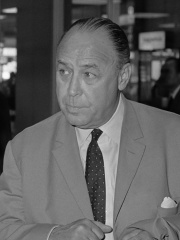
10. Karl Rappan (1905 - 1996)
With an HPI of 61.37, Karl Rappan is the 10th most famous Austrian Soccer Player. His biography has been translated into 22 different languages.
Karl Rappan (26 September 1905 – 2 January 1996) was an Austrian footballer and coach. He played and managed mostly in Switzerland, where he won multiple titles. He had four tenures as coach of the Switzerland national team, which he managed in three World Cups, and is the all-time leader in matches won as coach of the Swiss team. He introduced a major football strategy known as the "bolt", which gave origin to the catenaccio system. He also helped create the UEFA Intertoto Cup.
People
Pantheon has 238 people classified as Austrian soccer players born between 1888 and 2005. Of these 238, 170 (71.43%) of them are still alive today. The most famous living Austrian soccer players include Hans Krankl, Friedrich Koncilia, and Brian Laudrup. The most famous deceased Austrian soccer players include Josef Bican, Franz Binder, and Erich Probst. As of April 2024, 30 new Austrian soccer players have been added to Pantheon including Gerald Messlender, Josef Degeorgi, and Manfred Zsak.
Living Austrian Soccer Players
Go to all RankingsHans Krankl
1953 - Present
HPI: 66.38
Friedrich Koncilia
1948 - Present
HPI: 62.83
Brian Laudrup
1969 - Present
HPI: 62.57
Herbert Prohaska
1955 - Present
HPI: 60.31
Toni Polster
1964 - Present
HPI: 60.24
David Alaba
1992 - Present
HPI: 60.24
Josef Hickersberger
1948 - Present
HPI: 59.44
Marko Arnautović
1989 - Present
HPI: 58.83
Adi Hütter
1970 - Present
HPI: 58.56
Mateo Kovačić
1994 - Present
HPI: 57.59
Robert Sara
1946 - Present
HPI: 56.94
Kurt Jara
1950 - Present
HPI: 56.81
Deceased Austrian Soccer Players
Go to all RankingsJosef Bican
1913 - 2001
HPI: 75.26
Franz Binder
1911 - 1989
HPI: 62.95
Erich Probst
1927 - 1988
HPI: 62.52
Ernst Ocwirk
1926 - 1980
HPI: 62.31
Richard Kohn
1888 - 1963
HPI: 62.20
Theodor Wagner
1927 - 2020
HPI: 61.80
Karl Rappan
1905 - 1996
HPI: 61.37
Gerhard Hanappi
1929 - 1980
HPI: 61.06
Ernst Stojaspal
1925 - 2002
HPI: 60.99
Alfred Körner
1926 - 2020
HPI: 60.91
Karl Koller
1929 - 2009
HPI: 60.69
Anton Schall
1907 - 1947
HPI: 60.68
Newly Added Austrian Soccer Players (2025)
Go to all RankingsGerald Messlender
1961 - 2019
HPI: 45.79
Josef Degeorgi
1960 - Present
HPI: 45.44
Manfred Zsak
1964 - Present
HPI: 44.95
Gerald Glatzmayer
1968 - 2001
HPI: 44.91
Kurt Russ
1964 - Present
HPI: 44.81
Gerhard Struber
1977 - Present
HPI: 41.16
Markus Weissenberger
1975 - Present
HPI: 38.92
Michael Gspurning
1981 - Present
HPI: 37.65
Flavius Daniliuc
2001 - Present
HPI: 36.53
Manuela Zinsberger
1995 - Present
HPI: 36.22
Marcel Büchel
1991 - Present
HPI: 35.65
Stefan Hierländer
1991 - Present
HPI: 35.57
Overlapping Lives
Which Soccer Players were alive at the same time? This visualization shows the lifespans of the 25 most globally memorable Soccer Players since 1700.


